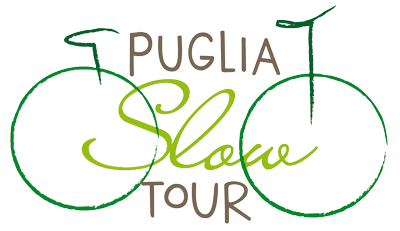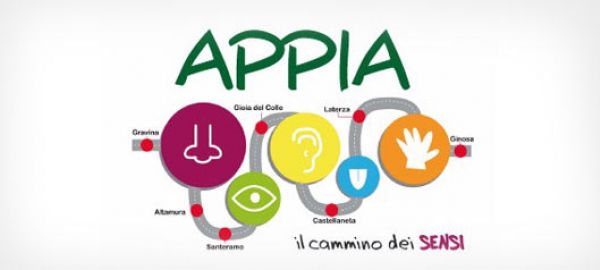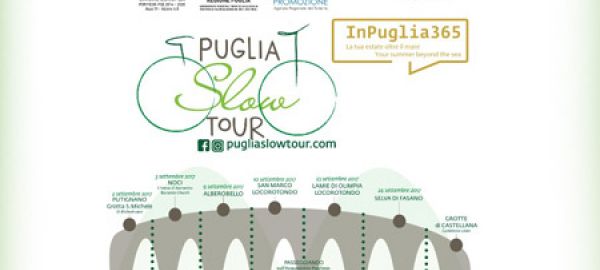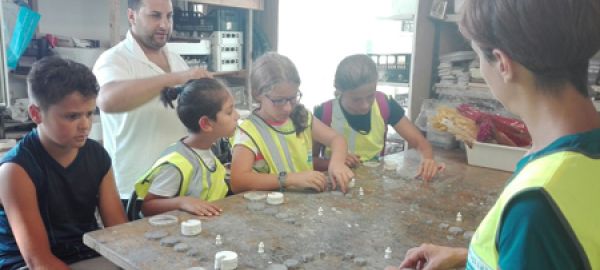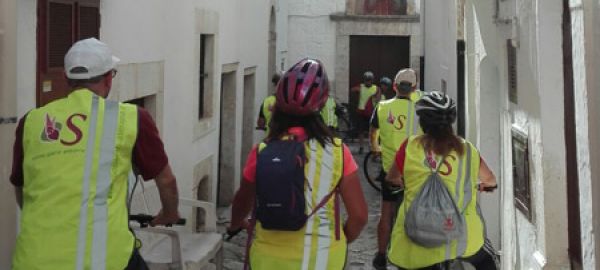First Step PugliaSlowTour: Putignano - Monte Laureto - Masseria Papaperta
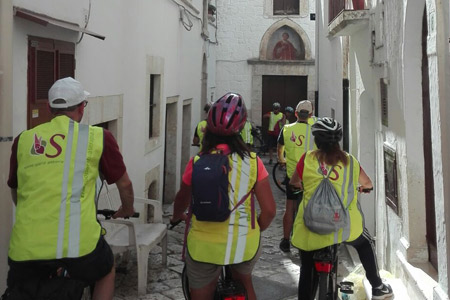
It's the first Saturday of September and it's 8:30: Putignano sleeps. However, we are proud of it: 16 adults and 1 child of 1,30 mt.
Reflective pettors on our feet, we ride on our bikes and enter the historic center past Porta Barsento. We are a colorful cloud in the white lanes of the Old Town. We walk along the Chiancata, ancient wall circle in the medieval period and main artery that up to the 18th century. it joins the only two entrances to the village, Porta Barsento and Porta Grande: here is Piazza Plebiscito, the fulcrum of the political power represented by the seat (ancient seat of the Town Hall), religious with the presence of the church of San Pietro Apostolo and noble for the ' look out over the Palazzo del Balì, home from the Middle Ages, of the Knights of Malta.
After some pedal we are already in front of the small church of Santo Stefano Piccolo: built in 1402 presents on the main portal a lunette with the representation of the patron saint of the city and worthy of note is the beautiful chiancarelle cover.
We resume the bikes and leave the old town. A steep downhill makes us think that the territory of Putignano varies from 295 to 456 mt s.l.m and that, if you go down, you will soon have to go up.
And so it was. 3 km of salt and go down to Monte Laureto. There is the San Michele Grotto there.
the place takes its name perhaps from a Greek laura, a kind of cenobio. Origin is uncertain, however, from 912 to 1045 there were Culnicens monks, followed by the Benedictine brothers, then the Knights of Malta who in 1506 entrusted the entire feud to the Carmelite brothers thanks to which the shrine was embellished and embellished. In 1809, with the suppression of the convents, the cave and the entire Monte Laureto became the property of Demanio; the property was purchased first by Count Rodolfo Acquaviva D'Aragona after Prince Lorenzo Romanizzi Carducci.
The sacred cave, bigger than the most famous gargantuan cave of St. Michael the Archangel, is now built inside a fenced area where there is a large architectural complex that has changed the use destination since construction but always in the sanitary area and social. In this context, the sacred place is recognizable by a bell tower on an ogival portal, beyond which a scenic staircase leads to the cave. To tell us everything and to welcome us is Pinuccio, president of the Pro Loco of Putignano. With so much passion and love for this mystical and fascinating place, Pinuccio leads us proudly into the cave. It's a jewel. To the left a niche contains a statue of the Virgin with Child: it looks like Stefano da Putignano's shop. There are concretions everywhere and in a corner of the grotto a dripping continues its work on the rock. at the school of Stefano da Putignano are also attributed the two newsstands at the sides of the altar: the left one conserves a polychrome statue by Michele Arcangelo (of the same sculptor), while in the right one stands an admirable fresco of Madonna with Child of 1538, overlaid by the cave with the representation of the Eternal. The central altar once has a mosaic ogival and features a 15th-century fresco on the back wall, a beautiful work that is composed of various moments and characters referring to the main episode of the whole representation: the Crucifixion.
Everything is magical and beautiful: a parallel world, underground, where nature and sacred blend into one thing.
Photos of rite and back in the saddle.
You will pedal under a burning sun to the Devil's Bridge: here is the Apulian aqueduct with its classic painted gates of yellow and black. Little is missing: we are more than halfway.
We still pedal and we realize that there is a stone different from the others in a dry wall: the cross of Malta is P and 23 carved, it is in fact one of the milestones marking the border between Putignano (P is for this ) and Nuts.
During the break we notice that in this tratturo we are surrounded by more, fig trees and pears: it is our hoped snack!
Fraggarts are beginning to give us some shade: we are in the county of Conea! We cross the provincial Noci - Barsento and we just have to support the wind and let us carry on the slopes of that road where we know that flowing waters that then went to enter the famous Cana River, the current Pirro Channel.
Let's look at our left of the barento church, we overcome it: our object is to reach Masseria Papaperta.
Built in 1700, Masseria Papaperta maintains intact all the artefacts that peasants with a laborious reclamation work carried out by cutting the oak trees and dissolving the stones.
we go through a white road: we are struck by an old pagoda surrounded by a lawn on which we all lay. Our bikes have brought us to a spectacular place: 6 trulli one near the other, pareti, aie, iazzi, fogia, for the collection of rain water, the lamies, barrel vault constructions for storing the straw, and in the end the rural buildings used for the massaro housing.
We enter the farm: under our bark, our table is set. Homemade red wine, meat and meatballs, freshly baked focaccia, fries, Martina Franca's capocolla, mozzarella and first salt, grilled vegetables and unmistakable beans and chicory.
They bring us to lunch the classic rotten taralli and the almond sweets: out of the rain and we go out to enjoy the cool hope murgiana.


